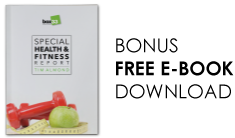Functional strength training not only makes you strong and builds a great physique it also has a practical purpose attached. What good is it to have perfectly chiselled shoulders and well defined biceps if you can’t lift a bag of cement?
You will develop strong legs, back, shoulder girdle and abs for lifting, holding, pushing, pulling, throwing and heaving heavy objects. When the whole body is strong and works synergistically, you develop a flow and strength that isn’t easily gained by traditional strength training.
When you focus on the functional side of training, the physique benefit become a happy side effect. Let’s be honest; you know you want to be functional, fit and have the ability to actually use the muscle and strength on your frame but another goal is to look good too.
Let’s look at how you can work toward both goals at the same time and kick butt outside of the gym too.
“It is time to train smarter. Stop limping out of the gym with your head hanging low, exhausted, frazzled. The idea of getting stronger is to add to quality to your life not take away from it.”
Kurt, Functional Training Coach at Adaptive Strength
Functional Fitness: A Change of Mindset
First and foremost you need to wipe the slate clean in your mind. Get away from the traditional thinking of pummeling a single body part until there is nothing left. Let’s start focusing on whole-body functionality – what your body is truly capable of when all those individual parts start working together like a well-oiled machine.
Shoring Up Common Weaknesses
One of the great things about Functional Strength Training is it will help address and fix many weak link. This isn’t an exhaustive list by any means, but will serve to point out some unknown problematic areas that will directly affect other lifts regarding strength and development.
The posterior chain
As this subject could be another article by itself, the posterior chain comprises all muscles comprising the posterior area of the body, functionally speaking. In other words all back musculature, lumbar, glutes and hams make up this often neglected area. Most lifters focus on the mirror muscles; chest, biceps and quads. Over worked pecs and underworked lats, for example, can pull the shoulders forward, concaving the chest. Weak hams and glutes can hinder not only the development of the quads but also the performance on squats and other lower leg moves.
Overhead pressing
Full range overhead pressing is a rare site in most gyms these days. A properly performed overhead press provides the entire shoulder girdle with stability and strength that will carry over into other lifts such as bench presses, pull-ups and rows.
Stabilization and core
With a heavy use of machines and seated exercises, there is a growing epidemic of weak cores. Your ability to stabilize your body serves to provide you with whole-body control and strength. Developing and strong core is key when you need lower back strength and a steady trunk.
Lower body range of motion
Limited ranges of motion are most common amongst lower body lifts. Can you get into a nice deep squat conformably? Developing muscle through a full range of motion will strengthen that muscle through the entire scope of its function.
Unilateral training imbalances
Utilizing too many machines and bilateral weight movements will eventually develop imbalances. One leg, hip, arm or shoulder stronger than the other will not only spell injury down the road but also significant strength differences from one side to the other. Unilateral training will quickly build balanced strength.
Bodyweight strength
Again, with the massive use of machines including plate-loaded machines, the average gym-goer’s ability to manipulate their bodyweight with purpose and control is rare. Real-world strength requires some form of bodyweight training including core development which is essential.
7 Training Variables For An Effective Functional Strength & Conditioning Workout
Below are some of the main variables you will utilize toward your new functionally fit body.
Strength: You will work with low reps to develop raw strength. Low reps and multi-joint movements will carefully be regulated regarding volume of work.
Muscle endurance: As an often overlooked aspect of performance, muscle endurance will not only serve as a functional benefit but will also aid in fat loss.
Power: The ability to move weight or your own bodyweight quickly and deliberately serves yet another important aspect of performance.
Cardiovascular endurance: For the most part, you will forego the traditional form of low intensity steady state (LISS) cardio exercise and adopt high intensity repeat training (HIRT). More efficient, more intense.
Speed and agility: Increasing your body’s ability to accelerate and inject some sprinting intervals will go a long way toward fat loss. Agility will enhance your ability to manipulate your bodyweight to change direction with speed and accuracy. It will also serve as good cardio work.
Prehab: This will include dynamic warm-ups and stretching and foam rolling. Priming and prepping the body for the work to come is essential for not only increased blood flow and performance but also longevity regarding the prevention of injury.
Range of motion and stretching: This will entail not only a stretching component at the conclusion of each training session but also adhering to a full range of motion of each exercise. The more a muscle stretches, the more it will contract.
Sample Training Plan: Functional Strength Training
If strength and conditioning are equally important to you, the following weekly kettlebell training template will serve you well.
Focus on strength twice a week and on conditioning twice a week. Train your endurance the day after strength:
- Monday—Strength
- Tuesday—Conditioning
- Wednesday—Off
- Thursday—Strength
- Friday—Conditioning
- Saturday—Off
- Sunday—Off
On Mondays and Thursdays, do military presses, front squats, pullups, deadlifts, and other low rep grinds.
Tuesdays and Fridays are all about high rep ballistics: swings and snatches, “High rep” in this context means 10-20. Drive your heart rate up and keep it there.
Sample Week #1 of the Kettlebell Training Template
Monday—Strength
A1) Turkish Get Up x 1/1
3 Rounds
B1) Deadlift x 5
B2) Military Press x 5/5
B3) Pull Up x 5
5 Rounds
C1) Split Stance Squat x 5/5
C2) TRX Row
C3) Deadbugs
Tuesday—Conditioning
One-arm swing – 5×10 per arm
Crawling 10 minutes
Wednesday—Off
Thursday—Strength
A1) Turkish Get Up x 1/1
3 Rounds
B1) Double Front Squats x 5
B2) Double Military Press x 5
B3) Gorilla Rows x 5/5
5 Rounds
C1) Split Stance Deadlift x 5/5
C2) Hanging Knee Raises
Friday—Conditioning
Kettlebell Snatch – 120 reps
Saturday—Off
Sunday—Off
Final Thoughts
Functional Training really is a great way to get strong, move well and feel great. You will walk the talk and be able to use the strength you gain in the gym and apply it to real life. On top of that it is one of the best ways to get into shape and look great!
If you would like to learn more about Functional Training or what we do here at Adaptive Strength book a quick 10min chat, with head Coach Sam.
Book your free 10min chat and assessment here.





